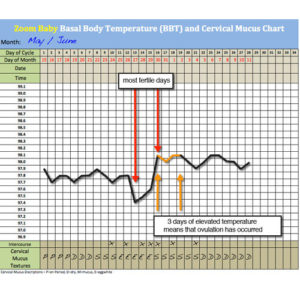If you’re trying to get pregnant you might consider charting Fertility Charting. This exercise helps to identify your peak days; allowing you to plan a time for intercourse that falls during your ‘peak’ time, thus increasing your chances of getting pregnant. There are only a few days each month that you’re most fertile; just before and during ovulation. Use a ‘P’ to mark your chart to keep track of your peak days.
Chart Your Peak Days
Your chart will allow you to keep track of your peak days by keeping track of the days that your cervical mucus is dry and days it is not; and every day in between. You may have noticed that as your menstrual cycle progresses the mucus becomes rather abundant. Just before you ovulate and also during ovulation the mucus will resemble the consistency of an egg-white; thin and clear.
When you’re trying to get pregnant and you reach this stage, you are most fertile and should plan intercourse to increase your chances of successfully getting pregnant. On your last day of the abundant mucus, mark your calendar with a ‘P’.
Peak Days & Pregnancy Prevention
If you are not trying to get pregnant and want to prevent such an occurrence, charting your peak day will help too. When you determine your peak day, wait at least four days after to engage in intercourse, but only if your mucus has dried. If you experience cervical mucus at any other time it’s best to use protection if engaging in intercourse while mucus is present.

Peak Days & Increasing Conception Chances
When trying to conceive it helps to keep a chart to track your peak days, however you will want to begin having intercourse in the days before your peak day. When your period has ended, your cervical mucus will increase noticeably. It first appears creamy-like and then changes to a more egg-white consistency; clear, thin and ‘stretchy’.
While you’re already aware that this indicates ovulation, it’s better to have intercourse before this mucus appears, if possible. Why? Sperm will survive for up to five days but your egg will only last 24 hours. Therefore, having intercourse prior to the appearance of mucus will increase your chances with more opportunities, rather than waiting until the day of noticeable mucus, only giving you a one day opportunity to try for pregnancy.
Additionally, knowing your peak days is important when trying to conceive because it’s the time when you’re most likely to ovulate. Peak days are usually around 14 days before your next period is due, but this can vary depending on the length of your menstrual cycle. Keeping track of your peak days and ovulation cycles can also help your doctor if you experience difficulties in conceiving.
There are a few methods to help determine your peak days and ovulation cycles. One method is to use an ovulation predictor kit, which measures the luteinising hormone (LH) in your urine that signals ovulation is about to occur. Another proven method is to keep track your basal body temperature. This typically rises by half a degree on the day of ovulation. At the same time, you should also try and track changes in your cervical mucus, as mentioned earlier.
It’s important to remember that while tracking your peak days can increase your chances of conception, it’s not a guarantee. Remember, it’s also important to maintain a healthy lifestyle, including eating a nutritious diet, exercising regularly, and avoiding unhealthy habits like smoking and excessive alcohol consumption. Try to be patient and seek medical advice if needed. Your GP will always advise you on anything you unsure about.
Understanding Your Menstrual Cycle
To get pregnant, it’s important to understand how your menstrual cycle works. The menstrual cycle is the process your body goes through to prepare for pregnancy each month.
A typical cycle lasts 28 days, but can range from 21 to 35 days. It begins on the first day of your period, which is when bleeding starts. The cycle is divided into three phases:
Follicular Phase
This phase starts on day 1 of your period. During this time, estrogen levels begin to rise and stimulate the growth of follicles in your ovaries. Each follicle contains an egg. Usually one dominant follicle will mature and release an egg.
The follicular phase lasts around 14 days, but can vary. Ovulation typically occurs at the end of this phase.
Ovulatory Phase
Ovulation occurs when the mature follicle ruptures and releases the egg. The egg travels down the fallopian tubes where it can be fertilised if sperm is present.
Ovulation usually happens around day 14 of a 28-day cycle. But it can occur anytime between day 11 and day 21 depending on the length of your cycle.
Luteal Phase
After ovulation, the empty follicle left behind transforms into the corpus luteum. This structure produces progesterone to thicken the uterine lining and prepare it for implantation.
If the egg isn’t fertilised, the corpus luteum will break down, progesterone levels fall and menstruation begins again. The luteal phase lasts around 14 days.
Recognising Ovulation Symptoms
Your body gives clues when you’re approaching ovulation. Here are key signs:
- Increase in cervical mucus – it becomes more slippery and egg white-like around ovulation.
- Mittelschmerz – some women experience ovarian pain or cramps during ovulation.
- Breast tenderness – your breasts may feel more tender and swollen.
- Higher basal body temperature – your temperature rises by 0.5-1°F after ovulation due to progesterone.
- Positive OPK – ovulation predictor kits detect the LH surge 24-36 hours before ovulation.
- Higher libido – you may notice an increased sex drive around your fertile window.
Paying attention to these signs can help pinpoint your fertile window for the best timing of intercourse. Consider combining observation of cervical mucus and BBT charting for the most accurate prediction.
When to Have Sex
You’re most fertile in the 2-3 days before and on the day of ovulation. But sperm can survive for 3-5 days inside you.
So it’s a good idea to have sex in the days leading up to ovulation – this gives the sperm time to be there when the egg is released. Don’t wait until your suspected ovulation day.
Every other day or every 2-3 days is recommended around your fertile window. While daily sex can also be effective for some couples, this frequency may lower sperm count for others.
Listen to your body and go by your fertile signs. Having well-timed intercourse is key for conception success!
Start Fertility Charting with our FREE Fertility Chart
A Basal Thermometer is a key purchase if you are going to be charting your basal body temperature (BBT) each month. Variations in basal temperature can help you track the changes in menstrual cycle and predict when ovulation might occur. Once you have predicted your most fertile period you can schedule intercourse accordingly.
All of our basal thermometers are supplied with a FREE Fertility Chart which can be downloaded and printed out. Remember to order a reliable ovulation thermometer to use with this chart. Don’t forget, you can also use ovulation tests when you are fertility charting.
Photo by Zoom Baby
Zoom Baby is a leading supplier of Pregnancy Tests and Ovulation Test Kits





